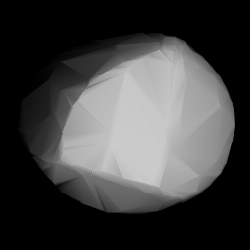Astronomy:1904 Massevitch
 Massevitch modeled from its lightcurve | |
| Discovery[1] | |
|---|---|
| Discovered by | T. Smirnova |
| Discovery site | Crimean Astrophysical Obs. |
| Discovery date | 9 May 1972 |
| Designations | |
| (1904) Massevitch | |
| Named after | Alla Massevitch (astronomer)[2] |
| 1972 JM · 1949 JH 1951 XN · 1958 JA 1962 CE · 1965 YH 1971 BF | |
| Minor planet category | main-belt · (middle) |
| Orbital characteristics[1] | |
| Epoch 4 September 2017 (JD 2458000.5) | |
| Uncertainty parameter 0 | |
| Observation arc | 68.09 yr (24,870 days) |
| |{{{apsis}}}|helion}} | 2.9442 AU |
| |{{{apsis}}}|helion}} | 2.5477 AU |
| 2.7460 AU | |
| Eccentricity | 0.0722 |
| Orbital period | 4.55 yr (1,662 days) |
| Mean anomaly | 218.92° |
| Mean motion | 0° 12m 59.76s / day |
| Inclination | 12.817° |
| Longitude of ascending node | 106.40° |
| 261.22° | |
| Physical characteristics | |
| Dimensions | 13.503±0.211 km[3] 18.19 km (IRAS)[4] 18.25 km (derived)[5] |
| Rotation period | 5.394±0.003 h[6] |
| Geometric albedo | 0.1613 (IRAS)[4] 0.1756 (derived)[5] 0.581±0.228[3] |
| SMASS = R[1][5] | |
| Absolute magnitude (H) | 10.55[3] · 11.2[1][5] · 11.21±0.49[7] |
1904 Massevitch (prov. designation: 1972 JM) is a background asteroid from the central region of the asteroid belt. It was discovered on 9 May 1972, by the Russian astronomer Tamara Smirnova at the Crimean Astrophysical Observatory in Nauchnyj, on the Crimean peninsula.[8] The uncommon R-type asteroid has a rotation period of 5.3 hours and measures approximately 16 kilometers (9.9 miles) in diameter. It was later named after Russian astrophysicist Alla Masevich.[2]
Orbit
Massevitch orbits the Sun in the central main-belt at a distance of 2.5–2.9 AU once every 4 years and 7 months (1,662 days). Its orbit has an eccentricity of 0.07 and an inclination of 13° with respect to the ecliptic.[1] It was first identified as 1949 JH at Goethe Link Observatory in 1949, extending the body's observation arc by 23 years prior to its discovery observation.[8]
Naming
This minor planet was named after Russian astrophysicist and astronomer Alla Genrichovna Massevitch (born 1918), vice-president of the Astronomical Council of the former USSR Academy of Sciences (now Russian Academy of Sciences). In the former USSR, Massevitch organized the optical tracking of artificial satellites in Earth's orbit.[2] The official naming citation was published by the Minor Planet Center on 20 February 1976 (M.P.C. 3936).[9]
Physical characteristics
The moderately bright R-type asteroid has a surface that strongly absorbs in the olivine and pyroxene spectral region, which give it its very reddish color.[1]
Rotation period
In September 2014, a rotational lightcurve of Massevitch was obtained from photometric observations taken at the Oakley Southern Sky Observatory (E09) in Coonabarabran, Australia. It gave a rotation period of 5.394 hours with a brightness variation of 0.30 magnitude ({{{1}}})[6]
Diameter and albedo
According to the surveys carried out by NASA's Wide-field Infrared Survey Explorer with its subsequent NEOWISE mission and the Infrared Astronomical Satellite IRAS, Massevitch measures 13.50 and 18.19 kilometers in diameter, and its surface has an albedo of 0.161 and 0.581, respectively,[3][4] while the Collaborative Asteroid Lightcurve Link derives an albedo of 0.176 and a diameter of 18.25 kilometers with an absolute magnitude of 11.2.[5]
References
- ↑ 1.0 1.1 1.2 1.3 1.4 1.5 "JPL Small-Body Database Browser: 1904 Massevitch (1972 JM)". Jet Propulsion Laboratory. https://ssd.jpl.nasa.gov/sbdb.cgi?sstr=2001904. Retrieved 1 July 2017.
- ↑ 2.0 2.1 2.2 Schmadel, Lutz D. (2007). "(1904) Massevitch". Dictionary of Minor Planet Names. Springer Berlin Heidelberg. p. 153. doi:10.1007/978-3-540-29925-7_1905. ISBN 978-3-540-00238-3. https://archive.org/details/dictionaryminorp00schm.
- ↑ 3.0 3.1 3.2 3.3 Masiero, Joseph R.; Mainzer, A. K.; Grav, T.; Bauer, J. M.; Cutri, R. M.; Nugent, C. et al. (November 2012). "Preliminary Analysis of WISE/NEOWISE 3-Band Cryogenic and Post-cryogenic Observations of Main Belt Asteroids". The Astrophysical Journal Letters 759 (1): 5. doi:10.1088/2041-8205/759/1/L8. Bibcode: 2012ApJ...759L...8M. http://adsabs.harvard.edu/cgi-bin/bib_query?bibcode=2012ApJ...759L...8M. Retrieved 11 December 2016.
- ↑ 4.0 4.1 4.2 Tedesco, E. F.; Noah, P. V.; Noah, M.; Price, S. D. (October 2004). "IRAS Minor Planet Survey V6.0". NASA Planetary Data System – IRAS-A-FPA-3-RDR-IMPS-V6.0. Bibcode: 2004PDSS...12.....T. https://sbnarchive.psi.edu/pds3/iras/IRAS_A_FPA_3_RDR_IMPS_V6_0/data/diamalb.tab. Retrieved 17 October 2019.
- ↑ 5.0 5.1 5.2 5.3 5.4 "LCDB Data for (1904) Massevitch". Asteroid Lightcurve Database (LCDB). http://www.minorplanet.info/PHP/generateOneAsteroidInfo.php?AstInfo=1904%7CMassevitch. Retrieved 11 December 2016.
- ↑ 6.0 6.1 Bohn, Lucas; Hibbler, Brianna; Stein, Gregory; Ditteon, Richard (April 2015). "Asteroid Lightcurve Analysis at the Oakley Southern Sky Observatory: 2014 September". Minor Planet Bulletin 42 (2): 89–90. ISSN 1052-8091. Bibcode: 2015MPBu...42...89B. http://www.minorplanet.info/MPB/issues/MPB_42-2.pdf. Retrieved 17 March 2020.
- ↑ Veres, Peter; Jedicke, Robert; Fitzsimmons, Alan; Denneau, Larry; Granvik, Mikael; Bolin, Bryce et al. (November 2015). "Absolute magnitudes and slope parameters for 250,000 asteroids observed by Pan-STARRS PS1 - Preliminary results". Icarus 261: 34–47. doi:10.1016/j.icarus.2015.08.007. Bibcode: 2015Icar..261...34V. http://adsabs.harvard.edu/cgi-bin/bib_query?bibcode=2015Icar..261...34V. Retrieved 11 December 2016.
- ↑ 8.0 8.1 "1904 Massevitch (1972 JM)". Minor Planet Center. https://www.minorplanetcenter.net/db_search/show_object?object_id=1904. Retrieved 11 December 2016.
- ↑ Schmadel, Lutz D. (2009). "Appendix – Publication Dates of the MPCs". Dictionary of Minor Planet Names – Addendum to Fifth Edition (2006–2008). Springer Berlin Heidelberg. p. 221. doi:10.1007/978-3-642-01965-4. ISBN 978-3-642-01964-7. https://archive.org/details/dictionaryminorp2008schm.
External links
- Lightcurve Database Query (LCDB), at www.minorplanet.info
- Dictionary of Minor Planet Names, Google books
- Asteroids and comets rotation curves, CdR – Geneva Observatory, Raoul Behrend
- Discovery Circumstances: Numbered Minor Planets (1)-(5000) – Minor Planet Center
- 1904 Massevitch at AstDyS-2, Asteroids—Dynamic Site
- 1904 Massevitch at the JPL Small-Body Database
 |

